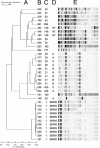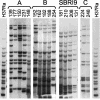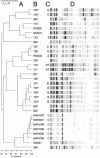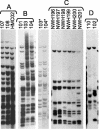Evaluation of a high-throughput repetitive-sequence-based PCR system for DNA fingerprinting of Mycobacterium tuberculosis and Mycobacterium avium complex strains
- PMID: 15184453
- PMCID: PMC427895
- DOI: 10.1128/JCM.42.6.2685-2693.2004
Evaluation of a high-throughput repetitive-sequence-based PCR system for DNA fingerprinting of Mycobacterium tuberculosis and Mycobacterium avium complex strains
Abstract
Repetitive-sequence-based PCR (rep-PCR) is useful for generating DNA fingerprints of diverse bacterial and fungal species. Rep-PCR amplicon fingerprints represent genomic segments lying between repetitive sequences. A commercial system that electrophoretically separates rep-PCR amplicons on microfluidic chips, and provides computer-generated readouts of results has been adapted for use with Mycobacterium species. The ability of this system to type M. tuberculosis and M. avium complex (MAC) isolates was evaluated. M. tuberculosis strains (n = 56) were typed by spoligotyping with rep-PCR as a high-resolution adjunct. Results were compared with those generated by a standard approach of spoligotyping with IS6110-targeted restriction fragment length polymorphism (IS6110-RFLP) as the high-resolution adjunct. The sample included 11 epidemiologically and genotypically linked outbreak isolates and a population-based sample of 45 isolates from recent immigrants to Seattle, Wash., from the African Horn countries of Somalia, Eritrea, and Ethiopia. Twenty isolates exhibited unique spoligotypes and were not analyzed further. Of the 36 outbreak and African Horn isolates with nonunique spoligotypes, 23 fell into four clusters identified by IS6110-RFLP and rep-PCR, with 97% concordance observed between the two methods. Both approaches revealed extensive strain heterogeneity within the African Horn sample, consistent with a predominant pattern of reactivation of latent infections in this immigrant population. Rep-PCR exhibited 89% concordance with IS1245-RFLP typing of 28 M. avium subspecies avium strains. For M. tuberculosis as well as M. avium subspecies avium, the discriminative power of rep-PCR equaled or exceeded that of RFLP. Rep-PCR also generated DNA fingerprints from M. intracellulare (n = 8) and MAC(x) (n = 2) strains. It shows promise as a fast, unified method for high-throughput genotypic fingerprinting of multiple Mycobacterium species.
Figures





References
-
- Anonymous. 2002. Increase in African immigrants and refugees with tuberculosis—Seattle-King County, Washington, 1998-2001. Morbid. Mortal. Wkly. Rep. 51:882-883. - PubMed
-
- Arbeit, R. D., A. Slutsky, T. W. Barber, J. N. Maslow, S. Niemczyk, J. O. Falkinham III, G. T. O'Connor, and C. F. von Reyn. 1993. Genetic diversity among strains of Mycobacterium avium causing monoclonal and polyclonal bacteremia in patients with AIDS. J. Infect. Dis. 167:1384-1390. - PubMed
-
- Barnes, P. F., and M. D. Cave. 2003. Molecular epidemiology of tuberculosis. N. Engl. J. Med. 349:1149-1156. - PubMed
-
- Bifani, P. J., B. Mathema, Z. Liu, S. L. Moghazeh, B. Shopsin, B. Tempalski, J. Driscoll, R. Frothingham, J. M. Musser, P. Alcabes, and B. N. Kreiswirth. 1999. Identification of a W variant outbreak of Mycobacterium tuberculosis via population-based molecular epidemiology. JAMA 282:2321-2327. - PubMed
Publication types
MeSH terms
Grants and funding
LinkOut - more resources
Full Text Sources
Other Literature Sources

